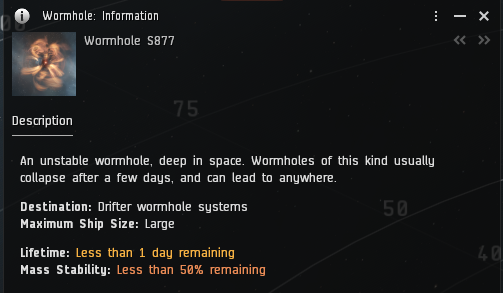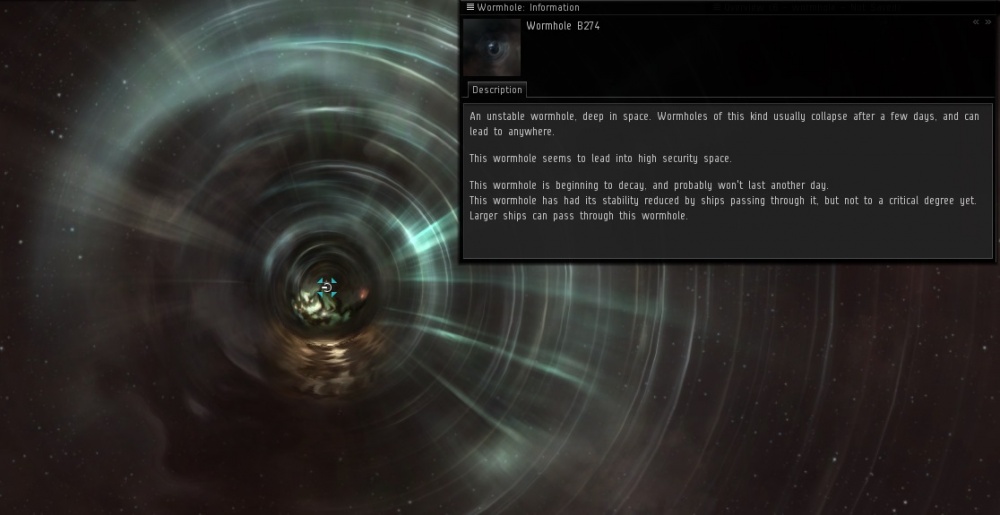More actions
mNo edit summary |
Idalia Voss (talk | contribs) →Lifetime: wormholes don't immediately collapse once the lifetime has passed |
||
| (290 intermediate revisions by more than 100 users not shown) | |||
| Line 1: | Line 1: | ||
{{Wormhole Links}} | |||
{{related class | Wormhole Mechanics (Class) | Wormhole PVE (Class) | Wormhole PVP (Class) | Wormhole Living (Class) }} | |||
'''Wormholes''' are rifts in space that connect two star systems. Like [[stargates]], they allow the travel of ships from one star system to another, but unlike stargates, wormholes are not permanent. They connect two systems for only a short time and collapse when either their lifespan ends or too many ships have passed through them. | |||
Wormholes | Wormholes can connect any two systems regardless of distance from each other, providing temporary shortcuts to areas that would otherwise take many jumps to reach. Wormholes frequently connect to [[wormhole space]]. | ||
== | == Finding wormholes == | ||
[[File:Wormholec3.jpg|200px|thumb|A wormhole leading to W-Space]] | |||
Wormholes can be found by [[Probe scanning|scanning]] down [[cosmic signatures]]. Once a wormhole is probed down, it can be warped to and jumped through much like a stargate, though unlike gates they must be warped to and then jumped through as a two-step process. | |||
'''IMPORTANT NEW PLAYER TIP:''' If you've found a wormhole, by all means see what's on the other side if you're curious, but use a cheap ship you can afford to lose, and also a [[clone]] you can afford to lose. Make sure the ship you use has core probes and a probe launcher fitted on it. When you pass through the wormhole, immediately '''right-click and bookmark your entry wormhole''' before doing anything else. The game does not automatically record your entrance's location, and if you warp away without bookmarking it, you will have to probe your entrance down. If the worst comes to the worst and you find yourself stranded in wormhole space with no probes, you can try contacting [https://evescoutrescue.com/home/ EvE-Scout Rescue], who might be able to help. | |||
== Destinations == | |||
Wormholes lead to many different places: some connect W-Space to mapped New Eden systems (henceforth [[Known Space]] or K-Space), others connect from K-Space to W-Space, yet others connect W-Space to other W-Space systems, and some wormholes connect K-Space to K-Space. Wormholes occurring within a W-Space system provide the sole method of inter-system travel for residents of that wormhole: there are no stargates in W-Space. | |||
'''Known Space to Known Space Wormholes''' are used to quickly travel throughout New Eden, they're also used to access high-sec or low-sec islands without risk of traveling through potentially dangerous space. They're commonly named for their sec status on both ends: High-to-high (H2H), low-to-null (L2N), null-to-high (N2H), etc. | |||
( | |||
'''Known Space to Wormhole Space Wormholes''' connect K-Space to W-Space. Players who do exploration use them to access W-Space to run cosmic anomalies and signatures. W-Space inhabitants use them to shop, resupply, sell loot and products and go on K-Space PvP roams. | |||
'''Wormhole Space to Wormhole Space Wormholes''' provide the sole means of interstellar transport between distinct W-Space systems, since there are no gates available. Their dynamic formation and dissolution define W-Space interactions, in the form of PvE—capsuleers killing sleeper rats—or PvP—capsuleers killing each other. W-Space to W-Space wormholes are very important, in part because high-class W-Space systems rarely get direct connections to K-Space. | |||
== Wormhole identification == | |||
{{main|Wormhole attributes}} | |||
The color of a wormhole may give you an impression on where it leads. The outline will be the color of your current system and the center will be colored based on where it leads. The color also changes based on the size of the wormhole. | |||
Right clicking and showing info on wormhole entrances will also display a short bit of text which reveals roughly about where they lead and their stability status. This text is explained below. | |||
By the name of the WH-system, you can determine its class, statics, possible signatures and anomalies with their NPC composition and damage from them. To do this, you can use the [https://whdb.scan-stakan.space date base of wormholes]. | |||
== Wormhole sizes and restrictions == | |||
Wormholes come with [[Wormhole attributes|different restrictions]]. Wormholes not only allow certain amounts of mass through them in their lifetime, but they also have mass restrictions for each particular transfer. For example, some wormholes from K-Space to C3 wormhole space will restrict ships going through to destroyers or smaller. | |||
Capital ships with jump drives can go through wormholes, providing the wormhole can support the ship's mass. [[Cynosural field]]s can be opened in wormhole space, but ships with jump drives cannot lock on to these fields, nor can they lock on to cynosural fields outside of wormhole space to jump out. Supercapital ships such as Titans and Supercarriers cannot go through wormholes at all, as they are far too large for even the largest wormholes. Capitals can be built in W-space, but they may not be able to take any of exits to K-space or even other W-space connections. Supercapitals cannot be built, as there is no sovereignty in [[wormhole space]]. | |||
The color of the flare around a wormhole can tell you the size of ships that can go through. Color Effects for wormholes are described in more detail in [[Visual wormhole identification]]. | |||
=== Polarization === | |||
Jumping through wormholes introduces additional restrictions on how often in a given time a pilot may jump through a particular wormhole. You may not jump through a wormhole in the same direction twice within five minutes. For example, if you jump through a wormhole at 05:00 and then jump back through the wormhole at 05:03, you will be polarized until 05:05, five minutes after your last transit in that direction. When polarized the wormhole will prevent you from jumping through, and present you with a message informing you how much time is left on your polarization timer. Similarly, if you were to jump as soon as the timer was up, you would be polarized on the other side of the hole until 05:08, five minutes after your last transit in ''that'' direction. | |||
One way to manage your polarization timer is to check local chat for time stamps (multiple wormhole jump time stamps are kept in the chat, unlike gate jumps in K-space) for your jumps and then plan accordingly. | |||
Keep in mind that this restriction applies to the pilot, not the ship or the account. The same ship can be swapped by ejection and boarding by different capsuleers for immediate transit through the same wormhole. This is very useful for [[Living_in_Wormhole_Space#Unwanted_Wormholes|mass reduction operations]] without need for multiple ships of same type. This is, however, a somewhat more dangerous way to roll a wormhole, as multiple pilots jumping from ship to ship are at least momentarily extremely vulnerable. | |||
=== Aggression === | |||
[[Timers|Weapon timers]] do not affect travel through wormholes; you still get them when you aggress capsuleers, but as long as you are not polarized you can jump through a wormhole immediately after aggressing any capsuleer in any manner. This can provide escape options even if you are webbed, scrammed, or bubbled. Aggression timers still prevent tethering and docking at citadels (and NPC stations in Thera), refitting in space, and anything else they normally prohibit. | |||
Although normal aggression does not prevent you from jumping holes, attempting to take a hole to escape from Concord's wrath will result in an error message stating that Concord is using "mysterious technology" to prevent you from jumping. | |||
== Wormhole text == | |||
When on grid with a wormhole entrance, right click on the entrance and click on ''show info''. This will give you information about the wormhole. There are 4 information sections. | |||
[[File:wormhole_info.png]] | |||
=== Destination === | |||
* Class 1-3 wormhole systems | |||
* Class 4-5 wormhole systems | |||
* Class 6 wormhole systems | |||
* High Security | |||
* Low Security | |||
* Null Security | |||
* Triglavian Space | |||
* Drifter Wormhole Systems | |||
* Thera | |||
# If the wormhole is named (anything other than K162) you can look up the location using [[Wormhole attributes|this table]]. You can also identify the size of ships allowed by its color. | |||
# If the wormhole is a K162, you can tell what type of system it leads to by color. | |||
=== Maximum Ship Size === | |||
{| class=" | {| class="wikitable" style='margin-left: 2em;" | ||
|- | |||
! Text !! Meaning | |||
! | |||
! | |||
! | |||
|- | |- | ||
| | | Extra large || All ships except for Titans and supercarriers can pass through this hole | ||
| | |||
| | |||
|- | |- | ||
| | | Large || Battleships, Orcas, and smaller ships can pass through this hole | ||
| | |||
| | |||
|- | |- | ||
| | | Medium || Unplated Nestors, battlecruisers and smaller ships can pass through this hole | ||
| | |||
| | |||
|- | |- | ||
| | | Small || Only frigates, destroyers, or specially fit HICs can pass through this hole | ||
| | |||
| | |||
|} | |} | ||
=== Wormhole Space | === Lifetime === | ||
The next section indicates the earliest possible time a wormhole could close, but there is some variance to when it will actually close after the lifetime has passed. | |||
* <span style="color:#F8B343">Less than 1 day remaining</span> | |||
* <span style="color:#F18F57">Less than 4 hours remaining</span> | |||
* <span style="color:#FF454B">Less than 1 hour remaining</span> | |||
It is therefore not recommended to traverse an end of life wormhole without some alternative method of returning back home, such as a corpmate able to scan down a new entrance. | |||
=== Mass Stability === | |||
* <span style="color:#55A2BA">More than 50% remaining</span> | |||
* <span style="color:#F28F58">Less than 50% remaining</span> | |||
* <span style="color:#F84349">Less than 10% remaining</span> | |||
== Wormhole statics == | |||
W-Space systems will always contain one or two wormholes that are referred to as "static". These wormholes, although they disappear with time as other wormholes, are more or less persistent : once the static wormhole collapses, another will re-open somewhere in the system, leading to a different system of same class. | |||
In wormholes of classes 2 and 4, there are usually two statics, and in 1 and 3, one each. | |||
For example, a Class 4 W-Space system can have a static Class 3 wormhole. As soon as the wormhole collapses, another wormhole opens to another Class 3 system. It can be very profitable to collapse a static wormhole on purpose, because it then means another neighboring system - and maybe another K-Space exit, as well as new combat and exploration sites to run, not to mention new neighbors to kill!! | |||
It can also be used to get rid of a connection to enemy corps or alliances inhabiting that precise system: by collapsing the wormhole you then prevent them from getting into your system, while still having another possible exit from the system. | |||
== Wormhole environment == | |||
When jumping into a wormhole space, a notice may advise you that there may be changes to the natural physics within this space. For example, you may find that all ships in this W-space have improved shields, or conversely, slower recharge times on shields. There are many possibilities, but remember that they apply to both you and anyone else in the W-space, although not necessarily the Sleepers. | |||
If there is an effect in play in a system, you will see the message, "Local spatial phenomena may cause strange effects on your ship systems." Look at the target system’s space background and compare with the examples below to determine which phenomena is being displayed. | |||
To determine the strength of the effect, you'll need to know what class the system is. This may be determined from the wormhole you came through. These effects do show up in your ship and module descriptions, so you can also use that to determine what type and strength the effect is. | |||
For more information, see [[Wormhole space#System_Effects|W-Space system effects]]. | |||
|- | |||
== | == Example wormholes == | ||
[[File:B274_Example.jpg|1000px|An example B274 wormhole with show info]] | |||
From the information popup on this wormhole we can tell quite a few things. | |||
* The B274 name means that this is an entrance, not an exit (which would be a K162). The difference doesn't mean much, at least mechanically, except that an entrance gives much more information. For example, the [[Wormhole Information]] article tells us that a B274 wormhole leads to high sec K-space, has a total mass allowance of 2,000,000,000 kg ± 10%, has a per-transit ship mass limit of 375,000,000 kg, and a maximum stable time of 24 hours. | |||
* The wormhole is beginning to decay, meaning it is more than 4 hours away from collapsing. Jumping through this hole is quite safe, timewise. | |||
* The wormhole has had its stability reduced by a significant amount of mass pushed through it. This is generally known as '''first shrink'''. The wormhole is still safe to transit in smaller ships. | |||
* Any ship that is Battleship size or smaller can pass through the hole (color of the flare is turquoise). | |||
* The cyan wedge around the wormhole entrance tells us that the wormhole has been bookmarked. | |||
[[File:2014.11.22.18.39.06.jpg|1000px|An example K162 wormhole with show info]] | |||
Again, we can tell quite a few things. | |||
| | |||
| | |||
* The K162 name means this is an exit. The name is generic, and we really cannot get any information about the hole - except, the color of the hole means we are going into a C2 system, and the color of the flare says large ships can pass through the wormhole. | |||
* The wormhole is beginning to decay, meaning it is more than 4 hours away from collapsing. Jumping through this hole is quite safe, timewise. | |||
* The wormhole has had its stability reduced by a significant amount of mass pushed through it. This is generally known as '''first shrink'''. The wormhole is still safe to transit in smaller ships. | |||
* Any ship that is Battleship size or smaller can pass through the hole (color of the flare is turquoise). | |||
* The cyan wedge around the wormhole entrance tells us that the wormhole has been bookmarked. | |||
[[File:O477_Example.jpg|1000px|An example O477 wormhole with show info]] | |||
Again, we can tell quite a few things. | |||
| | |||
| | |||
* The O477 name means that this is an entrance. A O477 wormhole leads to C3 W-Space (this can be visually identified by the color of the wormhole), has a total mass allowance of 2,000,000,000 kg ± 10%, has a per-transit ship mass limit of 375,000,000 kg, and a maximum stable time of 16 hours. | |||
* The wormhole is beginning to decay, meaning it is more than 4 hours away from collapsing. Jumping through this hole is quite safe, timewise. | |||
* The wormhole has had its stability critically disrupted by the mass of numerous ships passing through and is on the verge of collapse. This is generally known as '''crit'''. The wormhole is unsafe to transit, as it could collapse behind you and trap you in hostile space. Specially fitted HICs are used to collapse the hole. | |||
* Any ship that is Battleship size or smaller can pass through the hole (color of the flare is turquoise). | |||
* The cyan wedge around the wormhole entrance tells us that the wormhole has been bookmarked. | |||
== The death of a wormhole == | |||
After a certain amount of mass is transported through or after some time the wormhole will disappear, or ''collapse''. While most wormholes only last for 24 hours, there are some variations to this rule. When a static wormhole collapses a new one with the same properties will spawn somewhere else in the same system. It will have to be scanned down. When a non-static wormhole collapses it simply disappears forever. You can read more on static wormholes in the [[Wormhole space]] article. If you get a note saying, "As you pass through the wormhole you realize that it collapses behind you. Have you become trapped?" and do not have a HS static bookmarked or core probe scanner/core probes, call [https://evescoutrescue.com/copilot/911/911.php Signal Cartel 911]. | |||
You can artificially induce "premature" death of a wormhole ([[Living in Wormhole Space#Unwanted Wormholes|Unwanted Wormholes]]). This process is known as rolling. | |||
== History == | |||
Wormholes were introduced in the [http://community.eveonline.com/news/patch-notes/patch-notes-for-apocrypha-1 Apocrypha expansion]. | |||
Thera and the shattered wormholes were added in the [https://www.eveonline.com/news/view/thera-and-the-shattered-wormholes Rhea expansion]. | |||
The wormhole text was simplified in [https://www.eveonline.com/news/view/patch-notes-version-23-01 Version 23.01] | |||
== Notes == | |||
* | * The fourth wormhole state, "dissipating into the ether", exists in EVE Online's shared cache only. See this article's [[Talk:Wormholes#"dissipating into the ether"|Discussion page]]. | ||
[[Category:Wormholes]] | |||
[[Category:Exploration]] | |||
Latest revision as of 18:05, 1 November 2025

|
| Wormholes |
|---|
| Life in wormholes |
| EVE University specific |
| Reference |
| NPCs |
| External links |
| EVE University offers classes on: | |
Wormholes are rifts in space that connect two star systems. Like stargates, they allow the travel of ships from one star system to another, but unlike stargates, wormholes are not permanent. They connect two systems for only a short time and collapse when either their lifespan ends or too many ships have passed through them.
Wormholes can connect any two systems regardless of distance from each other, providing temporary shortcuts to areas that would otherwise take many jumps to reach. Wormholes frequently connect to wormhole space.
Finding wormholes
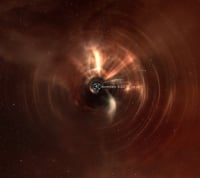
Wormholes can be found by scanning down cosmic signatures. Once a wormhole is probed down, it can be warped to and jumped through much like a stargate, though unlike gates they must be warped to and then jumped through as a two-step process.
IMPORTANT NEW PLAYER TIP: If you've found a wormhole, by all means see what's on the other side if you're curious, but use a cheap ship you can afford to lose, and also a clone you can afford to lose. Make sure the ship you use has core probes and a probe launcher fitted on it. When you pass through the wormhole, immediately right-click and bookmark your entry wormhole before doing anything else. The game does not automatically record your entrance's location, and if you warp away without bookmarking it, you will have to probe your entrance down. If the worst comes to the worst and you find yourself stranded in wormhole space with no probes, you can try contacting EvE-Scout Rescue, who might be able to help.
Destinations
Wormholes lead to many different places: some connect W-Space to mapped New Eden systems (henceforth Known Space or K-Space), others connect from K-Space to W-Space, yet others connect W-Space to other W-Space systems, and some wormholes connect K-Space to K-Space. Wormholes occurring within a W-Space system provide the sole method of inter-system travel for residents of that wormhole: there are no stargates in W-Space.
Known Space to Known Space Wormholes are used to quickly travel throughout New Eden, they're also used to access high-sec or low-sec islands without risk of traveling through potentially dangerous space. They're commonly named for their sec status on both ends: High-to-high (H2H), low-to-null (L2N), null-to-high (N2H), etc.
Known Space to Wormhole Space Wormholes connect K-Space to W-Space. Players who do exploration use them to access W-Space to run cosmic anomalies and signatures. W-Space inhabitants use them to shop, resupply, sell loot and products and go on K-Space PvP roams.
Wormhole Space to Wormhole Space Wormholes provide the sole means of interstellar transport between distinct W-Space systems, since there are no gates available. Their dynamic formation and dissolution define W-Space interactions, in the form of PvE—capsuleers killing sleeper rats—or PvP—capsuleers killing each other. W-Space to W-Space wormholes are very important, in part because high-class W-Space systems rarely get direct connections to K-Space.
Wormhole identification
- Main article: Wormhole attributes
The color of a wormhole may give you an impression on where it leads. The outline will be the color of your current system and the center will be colored based on where it leads. The color also changes based on the size of the wormhole.
Right clicking and showing info on wormhole entrances will also display a short bit of text which reveals roughly about where they lead and their stability status. This text is explained below.
By the name of the WH-system, you can determine its class, statics, possible signatures and anomalies with their NPC composition and damage from them. To do this, you can use the date base of wormholes.
Wormhole sizes and restrictions
Wormholes come with different restrictions. Wormholes not only allow certain amounts of mass through them in their lifetime, but they also have mass restrictions for each particular transfer. For example, some wormholes from K-Space to C3 wormhole space will restrict ships going through to destroyers or smaller.
Capital ships with jump drives can go through wormholes, providing the wormhole can support the ship's mass. Cynosural fields can be opened in wormhole space, but ships with jump drives cannot lock on to these fields, nor can they lock on to cynosural fields outside of wormhole space to jump out. Supercapital ships such as Titans and Supercarriers cannot go through wormholes at all, as they are far too large for even the largest wormholes. Capitals can be built in W-space, but they may not be able to take any of exits to K-space or even other W-space connections. Supercapitals cannot be built, as there is no sovereignty in wormhole space.
The color of the flare around a wormhole can tell you the size of ships that can go through. Color Effects for wormholes are described in more detail in Visual wormhole identification.
Polarization
Jumping through wormholes introduces additional restrictions on how often in a given time a pilot may jump through a particular wormhole. You may not jump through a wormhole in the same direction twice within five minutes. For example, if you jump through a wormhole at 05:00 and then jump back through the wormhole at 05:03, you will be polarized until 05:05, five minutes after your last transit in that direction. When polarized the wormhole will prevent you from jumping through, and present you with a message informing you how much time is left on your polarization timer. Similarly, if you were to jump as soon as the timer was up, you would be polarized on the other side of the hole until 05:08, five minutes after your last transit in that direction.
One way to manage your polarization timer is to check local chat for time stamps (multiple wormhole jump time stamps are kept in the chat, unlike gate jumps in K-space) for your jumps and then plan accordingly.
Keep in mind that this restriction applies to the pilot, not the ship or the account. The same ship can be swapped by ejection and boarding by different capsuleers for immediate transit through the same wormhole. This is very useful for mass reduction operations without need for multiple ships of same type. This is, however, a somewhat more dangerous way to roll a wormhole, as multiple pilots jumping from ship to ship are at least momentarily extremely vulnerable.
Aggression
Weapon timers do not affect travel through wormholes; you still get them when you aggress capsuleers, but as long as you are not polarized you can jump through a wormhole immediately after aggressing any capsuleer in any manner. This can provide escape options even if you are webbed, scrammed, or bubbled. Aggression timers still prevent tethering and docking at citadels (and NPC stations in Thera), refitting in space, and anything else they normally prohibit.
Although normal aggression does not prevent you from jumping holes, attempting to take a hole to escape from Concord's wrath will result in an error message stating that Concord is using "mysterious technology" to prevent you from jumping.
Wormhole text
When on grid with a wormhole entrance, right click on the entrance and click on show info. This will give you information about the wormhole. There are 4 information sections.
Destination
- Class 1-3 wormhole systems
- Class 4-5 wormhole systems
- Class 6 wormhole systems
- High Security
- Low Security
- Null Security
- Triglavian Space
- Drifter Wormhole Systems
- Thera
- If the wormhole is named (anything other than K162) you can look up the location using this table. You can also identify the size of ships allowed by its color.
- If the wormhole is a K162, you can tell what type of system it leads to by color.
Maximum Ship Size
| Text | Meaning |
|---|---|
| Extra large | All ships except for Titans and supercarriers can pass through this hole |
| Large | Battleships, Orcas, and smaller ships can pass through this hole |
| Medium | Unplated Nestors, battlecruisers and smaller ships can pass through this hole |
| Small | Only frigates, destroyers, or specially fit HICs can pass through this hole |
Lifetime
The next section indicates the earliest possible time a wormhole could close, but there is some variance to when it will actually close after the lifetime has passed.
- Less than 1 day remaining
- Less than 4 hours remaining
- Less than 1 hour remaining
It is therefore not recommended to traverse an end of life wormhole without some alternative method of returning back home, such as a corpmate able to scan down a new entrance.
Mass Stability
- More than 50% remaining
- Less than 50% remaining
- Less than 10% remaining
Wormhole statics
W-Space systems will always contain one or two wormholes that are referred to as "static". These wormholes, although they disappear with time as other wormholes, are more or less persistent : once the static wormhole collapses, another will re-open somewhere in the system, leading to a different system of same class.
In wormholes of classes 2 and 4, there are usually two statics, and in 1 and 3, one each.
For example, a Class 4 W-Space system can have a static Class 3 wormhole. As soon as the wormhole collapses, another wormhole opens to another Class 3 system. It can be very profitable to collapse a static wormhole on purpose, because it then means another neighboring system - and maybe another K-Space exit, as well as new combat and exploration sites to run, not to mention new neighbors to kill!!
It can also be used to get rid of a connection to enemy corps or alliances inhabiting that precise system: by collapsing the wormhole you then prevent them from getting into your system, while still having another possible exit from the system.
Wormhole environment
When jumping into a wormhole space, a notice may advise you that there may be changes to the natural physics within this space. For example, you may find that all ships in this W-space have improved shields, or conversely, slower recharge times on shields. There are many possibilities, but remember that they apply to both you and anyone else in the W-space, although not necessarily the Sleepers.
If there is an effect in play in a system, you will see the message, "Local spatial phenomena may cause strange effects on your ship systems." Look at the target system’s space background and compare with the examples below to determine which phenomena is being displayed.
To determine the strength of the effect, you'll need to know what class the system is. This may be determined from the wormhole you came through. These effects do show up in your ship and module descriptions, so you can also use that to determine what type and strength the effect is.
For more information, see W-Space system effects.
Example wormholes
From the information popup on this wormhole we can tell quite a few things.
- The B274 name means that this is an entrance, not an exit (which would be a K162). The difference doesn't mean much, at least mechanically, except that an entrance gives much more information. For example, the Wormhole Information article tells us that a B274 wormhole leads to high sec K-space, has a total mass allowance of 2,000,000,000 kg ± 10%, has a per-transit ship mass limit of 375,000,000 kg, and a maximum stable time of 24 hours.
- The wormhole is beginning to decay, meaning it is more than 4 hours away from collapsing. Jumping through this hole is quite safe, timewise.
- The wormhole has had its stability reduced by a significant amount of mass pushed through it. This is generally known as first shrink. The wormhole is still safe to transit in smaller ships.
- Any ship that is Battleship size or smaller can pass through the hole (color of the flare is turquoise).
- The cyan wedge around the wormhole entrance tells us that the wormhole has been bookmarked.
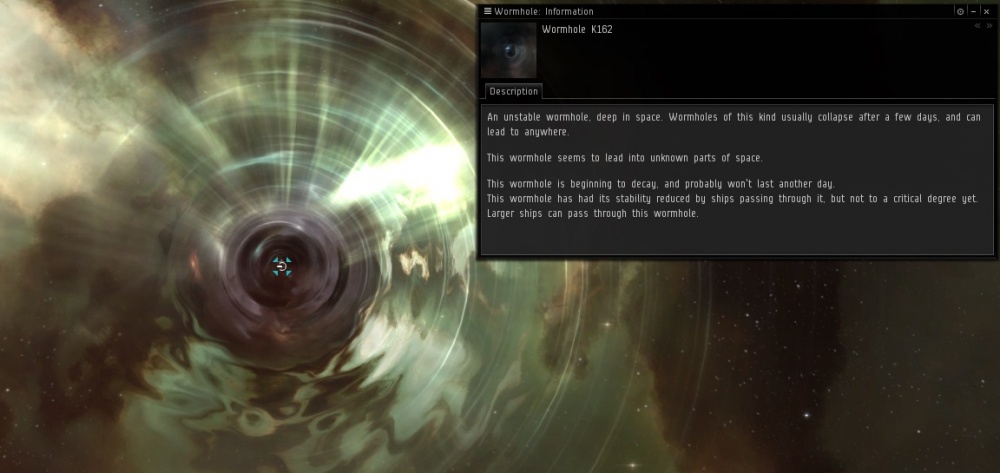 Again, we can tell quite a few things.
Again, we can tell quite a few things.
- The K162 name means this is an exit. The name is generic, and we really cannot get any information about the hole - except, the color of the hole means we are going into a C2 system, and the color of the flare says large ships can pass through the wormhole.
- The wormhole is beginning to decay, meaning it is more than 4 hours away from collapsing. Jumping through this hole is quite safe, timewise.
- The wormhole has had its stability reduced by a significant amount of mass pushed through it. This is generally known as first shrink. The wormhole is still safe to transit in smaller ships.
- Any ship that is Battleship size or smaller can pass through the hole (color of the flare is turquoise).
- The cyan wedge around the wormhole entrance tells us that the wormhole has been bookmarked.
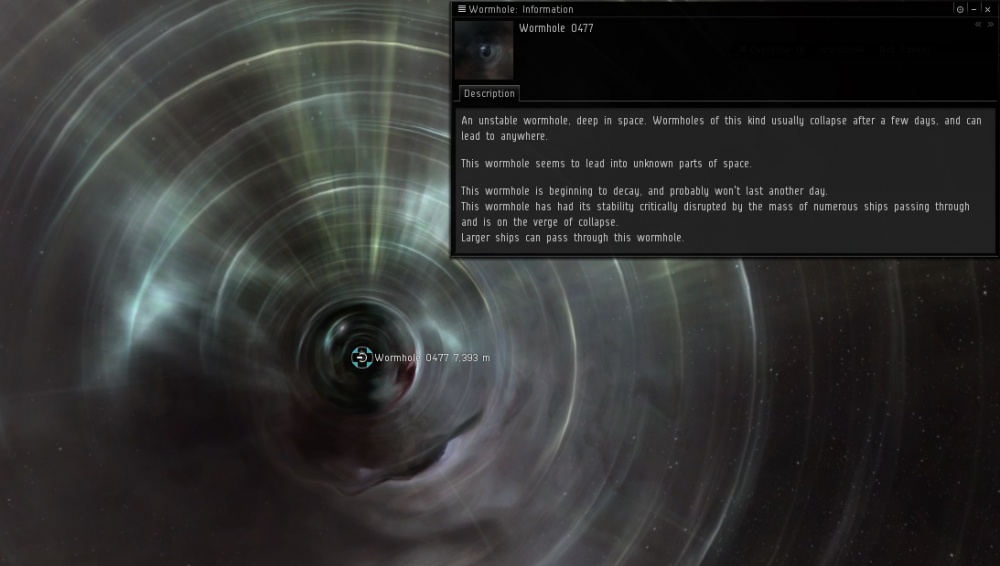 Again, we can tell quite a few things.
Again, we can tell quite a few things.
- The O477 name means that this is an entrance. A O477 wormhole leads to C3 W-Space (this can be visually identified by the color of the wormhole), has a total mass allowance of 2,000,000,000 kg ± 10%, has a per-transit ship mass limit of 375,000,000 kg, and a maximum stable time of 16 hours.
- The wormhole is beginning to decay, meaning it is more than 4 hours away from collapsing. Jumping through this hole is quite safe, timewise.
- The wormhole has had its stability critically disrupted by the mass of numerous ships passing through and is on the verge of collapse. This is generally known as crit. The wormhole is unsafe to transit, as it could collapse behind you and trap you in hostile space. Specially fitted HICs are used to collapse the hole.
- Any ship that is Battleship size or smaller can pass through the hole (color of the flare is turquoise).
- The cyan wedge around the wormhole entrance tells us that the wormhole has been bookmarked.
The death of a wormhole
After a certain amount of mass is transported through or after some time the wormhole will disappear, or collapse. While most wormholes only last for 24 hours, there are some variations to this rule. When a static wormhole collapses a new one with the same properties will spawn somewhere else in the same system. It will have to be scanned down. When a non-static wormhole collapses it simply disappears forever. You can read more on static wormholes in the Wormhole space article. If you get a note saying, "As you pass through the wormhole you realize that it collapses behind you. Have you become trapped?" and do not have a HS static bookmarked or core probe scanner/core probes, call Signal Cartel 911.
You can artificially induce "premature" death of a wormhole (Unwanted Wormholes). This process is known as rolling.
History
Wormholes were introduced in the Apocrypha expansion.
Thera and the shattered wormholes were added in the Rhea expansion.
The wormhole text was simplified in Version 23.01
Notes
- The fourth wormhole state, "dissipating into the ether", exists in EVE Online's shared cache only. See this article's Discussion page.

